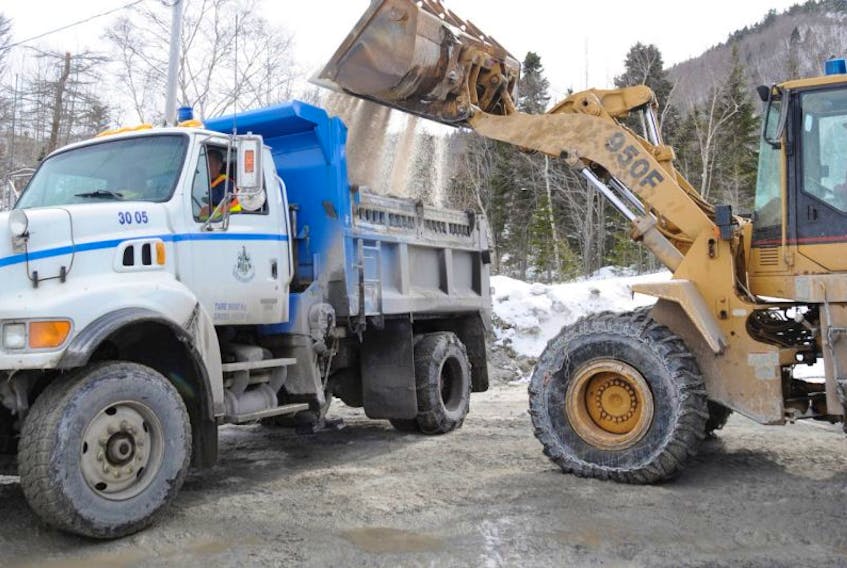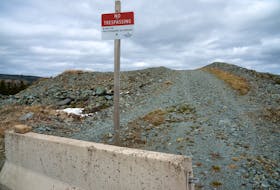Salt corrodes metal, and can accelerate the formation and spread of rust on a vehicle.
Because salt makes highways so much safer it’s unlikely its use will change any time soon. Instead, those who work on vehicles say owners should take steps to prevent corrosion.
Larry James, an employee of Fix Auto’s location in New Glasgow, N.S., said most cars come with a chip-protection coat when they’re new, but over time that wears away and it’s important to take steps to protect the vehicle.
He said undercoating is the best option for protecting against rust and recommends it be done annually. He said it’s best to do it in the summer when the weather is dry and the cars are at their cleanest.
Dave Koughan, of Bill Koughan Auto Body in Donagh, P.E.I., agrees, but said as long as it’s done in the fall it should be OK. He said any time before November is acceptable.
James said they often work on newer vehicles and try to reapply the chip-protection coat when they’re working on vehicles.
“It’s a process,” he said. “The surface has to be prepped and primed.”
Then the chip guard is put on, followed by paint. That’s something most people aren’t going to do unless their vehicle has been damaged in an accident.
If people pay attention to small spots, though, they can save themselves problems down the road. James said it’s when you get a chip or scratch on the car that you usually have rust spots start, although rust will build up naturally throughout a car as it ages.
“We can’t seem to get away from it,” he said.
Another practice the experts suggest is washing your vehicle regularly in the winter.
“It helps keep the salt off,” James said.
He particularly recommends spraying around the wheel wells.
Koughan said that can feel like a futile effort in long stretches of storms, but if there is a break in the weather, it can help.
Another step people can do to help protect their vehicles is lubricate hinges and to put rubber-care products on the weather stripping of doors to keep them from freezing.
This should ideally be done in the fall before cold temperatures come, but if you’ve procrastinated you could also take it into a garage or somewhere warm to treat it.
• • •
Salt and sand are the go-to products when it comes to melting ice and giving traction in Atlantic Canada, but how and when they’re used depends a lot on the conditions, says one industry expert.
Kevin Mitchell, director of operation services for the Nova Scotia Department of Transportation and Infrastructure Renewal, says when it comes to pre-emptive action, the snow removal crews in Atlantic Canada will often use brine — a salt-water solution — ahead of a storm to keep ice from forming in the first place and even melt some of the snow as it lands. The salt and water are mixed together in machines called brine-makers, which are automated to ensure the right ratio. The mix is sprayed from tanker trucks.
“The water evaporates and leaves salt residue on the road which keeps ice and snow from bonding to the pavement,” Mitchell explained.
The brine can also be used afterward to help melt ice, but that is less common.
When wintery precipitation is falling, the go-to standard on paved roads is salt for all the Atlantic provinces. Road salt is distributed directly by transportation department trucks.
“They have computer controls to measure out the exact amount of salt as they travel,” Mitchell said.
There comes a point where salt is no longer effective, though. While some people say salt will work until -20 C if you use enough, Mitchell said the standard is to stop using it after temperatures reach -10 C.
“At a certain point you can’t apply enough to keep the snow melted,” he said. “At some point all it does is make everything slippery.”
At that point they typically switch over to sand or another type of abrasive material such as crusher dust or chemical mixtures.
Since sand is so readily available in the Maritimes, that is the most common material.
Sand is also used exclusively on dirt roads, where salt is largely ineffective.
The sand grains have to be a particular size to work properly, so the sand is screened.
Other options for road treatment in winter are magnesium chloride or calcium chloride, but it is usually cost prohibitive, Mitchell said.
He advises people to use caution this time of year and be particularly careful when temperatures fall.
“Slow down and take your time. Leave lots of gaps between you and the vehicle in front of you.”
Winter driving advice
The transportations departments in Prince Edward Island, Newfoundland and Labrador, and Nova Scotia all offer tips for drivers to stay safe this winter. Some of their recommendations include:
Use winter tires. Install four matching winter tires between the months of November and April. Winter tires provide almost twice the traction of all-season tires on snow or ice. Look for the peaked mountain and snowflake symbol to ensure you are buying certified winter tires.
Slow down. Speed limits posted on the highways and on municipal roads are for ideal driving conditions, which are considered to be sunny summer days.
Know road conditions. Before you head out on the road, check the weather forecast so you know what to expect. Each province has resources on their websites to update highway conditions.
Leave room and look ahead. Slippery roads can inhibit your ability to react and stop. If you leave a greater distance between your car and the one in front of you, you can adjust more easily if someone suddenly stops or loses control ahead of you.
Allow extra time. It may take you longer to get to your destination, so you should allow extra time to get there on time. That way you will not feel rushed and drive too fast for the conditions of the roads.
Maintain visibility. Clear snow and ice from your windshield, windows, headlights and taillights. You want to be able to see well, and you want others to see you easily. Your wipers should be in good working condition, too, so they can clear snow from the windshield.
Salt corrodes metal, and can accelerate the formation and spread of rust on a vehicle.
Because salt makes highways so much safer it’s unlikely its use will change any time soon. Instead, those who work on vehicles say owners should take steps to prevent corrosion.
Larry James, an employee of Fix Auto’s location in New Glasgow, N.S., said most cars come with a chip-protection coat when they’re new, but over time that wears away and it’s important to take steps to protect the vehicle.
He said undercoating is the best option for protecting against rust and recommends it be done annually. He said it’s best to do it in the summer when the weather is dry and the cars are at their cleanest.
Dave Koughan, of Bill Koughan Auto Body in Donagh, P.E.I., agrees, but said as long as it’s done in the fall it should be OK. He said any time before November is acceptable.
James said they often work on newer vehicles and try to reapply the chip-protection coat when they’re working on vehicles.
“It’s a process,” he said. “The surface has to be prepped and primed.”
Then the chip guard is put on, followed by paint. That’s something most people aren’t going to do unless their vehicle has been damaged in an accident.
If people pay attention to small spots, though, they can save themselves problems down the road. James said it’s when you get a chip or scratch on the car that you usually have rust spots start, although rust will build up naturally throughout a car as it ages.
“We can’t seem to get away from it,” he said.
Another practice the experts suggest is washing your vehicle regularly in the winter.
“It helps keep the salt off,” James said.
He particularly recommends spraying around the wheel wells.
Koughan said that can feel like a futile effort in long stretches of storms, but if there is a break in the weather, it can help.
Another step people can do to help protect their vehicles is lubricate hinges and to put rubber-care products on the weather stripping of doors to keep them from freezing.
This should ideally be done in the fall before cold temperatures come, but if you’ve procrastinated you could also take it into a garage or somewhere warm to treat it.
• • •
Salt and sand are the go-to products when it comes to melting ice and giving traction in Atlantic Canada, but how and when they’re used depends a lot on the conditions, says one industry expert.
Kevin Mitchell, director of operation services for the Nova Scotia Department of Transportation and Infrastructure Renewal, says when it comes to pre-emptive action, the snow removal crews in Atlantic Canada will often use brine — a salt-water solution — ahead of a storm to keep ice from forming in the first place and even melt some of the snow as it lands. The salt and water are mixed together in machines called brine-makers, which are automated to ensure the right ratio. The mix is sprayed from tanker trucks.
“The water evaporates and leaves salt residue on the road which keeps ice and snow from bonding to the pavement,” Mitchell explained.
The brine can also be used afterward to help melt ice, but that is less common.
When wintery precipitation is falling, the go-to standard on paved roads is salt for all the Atlantic provinces. Road salt is distributed directly by transportation department trucks.
“They have computer controls to measure out the exact amount of salt as they travel,” Mitchell said.
There comes a point where salt is no longer effective, though. While some people say salt will work until -20 C if you use enough, Mitchell said the standard is to stop using it after temperatures reach -10 C.
“At a certain point you can’t apply enough to keep the snow melted,” he said. “At some point all it does is make everything slippery.”
At that point they typically switch over to sand or another type of abrasive material such as crusher dust or chemical mixtures.
Since sand is so readily available in the Maritimes, that is the most common material.
Sand is also used exclusively on dirt roads, where salt is largely ineffective.
The sand grains have to be a particular size to work properly, so the sand is screened.
Other options for road treatment in winter are magnesium chloride or calcium chloride, but it is usually cost prohibitive, Mitchell said.
He advises people to use caution this time of year and be particularly careful when temperatures fall.
“Slow down and take your time. Leave lots of gaps between you and the vehicle in front of you.”
Winter driving advice
The transportations departments in Prince Edward Island, Newfoundland and Labrador, and Nova Scotia all offer tips for drivers to stay safe this winter. Some of their recommendations include:
Use winter tires. Install four matching winter tires between the months of November and April. Winter tires provide almost twice the traction of all-season tires on snow or ice. Look for the peaked mountain and snowflake symbol to ensure you are buying certified winter tires.
Slow down. Speed limits posted on the highways and on municipal roads are for ideal driving conditions, which are considered to be sunny summer days.
Know road conditions. Before you head out on the road, check the weather forecast so you know what to expect. Each province has resources on their websites to update highway conditions.
Leave room and look ahead. Slippery roads can inhibit your ability to react and stop. If you leave a greater distance between your car and the one in front of you, you can adjust more easily if someone suddenly stops or loses control ahead of you.
Allow extra time. It may take you longer to get to your destination, so you should allow extra time to get there on time. That way you will not feel rushed and drive too fast for the conditions of the roads.
Maintain visibility. Clear snow and ice from your windshield, windows, headlights and taillights. You want to be able to see well, and you want others to see you easily. Your wipers should be in good working condition, too, so they can clear snow from the windshield.









